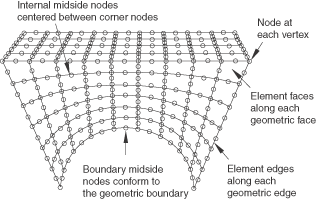Generating a mesh | ||
| ||
- Abaqus/CAE
follows these basic steps to generate a mesh:
Generate a mesh on each top-down region using the meshing technique currently assigned to that region. By default, Abaqus/CAE generates meshes with first-order line, quadrilateral, or hexahedral elements throughout.
-
Merge the meshes of all regions into a single mesh. Typically, Abaqus/CAE merges the nodes along the common boundaries of neighboring regions into a single set of nodes. However, in certain cases Abaqus/CAE creates tied surface interactions instead of merging these nodes; for example, along the common interface between hexahedral and tetrahedral meshes. For more information, see Meshing multiple three-dimensional solid regions.
Top-down meshes generated by Abaqus/CAE conform to the geometry of the part or part instance they discretize, as shown in Figure 1:

-
A node is generated at each geometric vertex.
-
A connected set of element edges is generated along each geometric edge.
-
A connected set of element faces is generated along each geometric face.
-
Nodes that are on the boundary of the mesh (including the midside nodes of second-order elements) are also on the boundary of the geometry.
-
Midside nodes of internal second-order elements are centered between the end nodes of the element edges.
For detailed, step-by-step instructions on creating a top-down mesh, see Creating a mesh.
Relying directly on the geometry to form the outer mesh boundaries can impact mesh quality as Abaqus/CAE creates elements to fill small details. In some cases you may not be able to implement a partitioning strategy that allows you to apply a top-down swept or structured meshing technique on a complex region. For solid regions, you can use the bottom-up meshing technique in place of the automated top-down meshing techniques to generate a hexahedral mesh. Bottom-up meshing is a manual, incremental meshing process that builds up a three-dimensional mesh from two-dimensional entities. You define the regions that will be meshed using the bottom-up technique, control the meshing process, decide whether the resulting mesh meets your needs, and—since the mesh is not required to conform to the geometry— control the associativity of the geometry to the mesh. For more information on bottom-up meshing, see Bottom-up meshing.